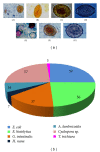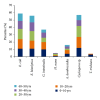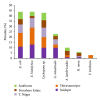Comparative study of the prevalence of intestinal parasites in low socioeconomic areas from South chennai, India
- PMID: 24587897
- PMCID: PMC3918716
- DOI: 10.1155/2014/630968
Comparative study of the prevalence of intestinal parasites in low socioeconomic areas from South chennai, India
Abstract
Intestinal parasites cause one of the most important health problems through their effects in causing undernourishment morbidity and incapacitation due to their behavior particularly in children compared to adults. This study was intended to state the prevalence of intestinal parasites between the slum dwellers of different areas in south Chennai. Among the total of 256 samples collected between the ages of 0-50 yrs, 194 samples were positive. Standard laboratory techniques for parasitological diagnosis were carried out for each sample. Entamoeba coli (23%), Cyclospora sp. (22.2%), Entamoeba histolytica (21.8%), Giardia intestinalis (14.4%), Ascaris lumbricoides (6.2%), Trichuris trichiura (1.1%), and Hymenolepis nana (2.7%) were found in the dwellers of low socioeconomic areas. The data on the prevalence of parasites with respect to sex and age showed that the females harbored more numbers of parasites when compared to males. Further, with respect to age, children and teenagers had surplus parasites compared to old age groups. The percentage of educational status showed a reduction in the number of parasites in the higher education dwellers. These parasites could be prevented by possible grouping of better ecological design and hygiene. Conclusively, the examination of personal hygiene as well as routine medical examination and treatment is strongly recommended in the low socio-economic areas.
Figures






References
-
- Odu NN, Akujobi CO, Maxwell SN, Nte AR. Impact of mass deworming of school children in rural communities in Rivers State, Nigeria: option for programme sustainability. Acta Parasitologica. 2011;2:20–24.
-
- Mordi RM, Ngwodo POA. A study of blood and gastro-intestinal parasites in Edo state. African Journal of Biotechnology. 2007;6(19):2201–2207.
-
- Alli JA, Kolade AF, Okonko IO, et al. Prevalence of intestinal nematode infection among pregnant women attending antenatal clinic at the University College Hospital, Ibadan, Nigeria. Advances in Applied Science Research. 2011;2:1–13.
-
- Loukopoulos P, Komnenou A, Papadopoulos E, Psychas V. Lethal ozolaimus megatyphlon infection in a green iguana (Iguana iguana rhinolopa) Journal of Zoo and Wildlife Medicine. 2007;38(1):131–134. - PubMed
LinkOut - more resources
Full Text Sources
Other Literature Sources

